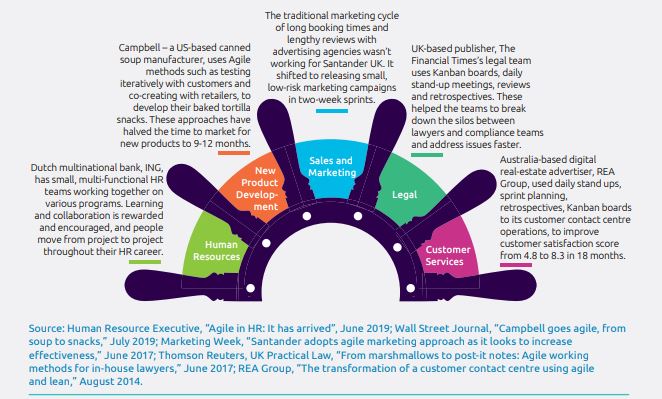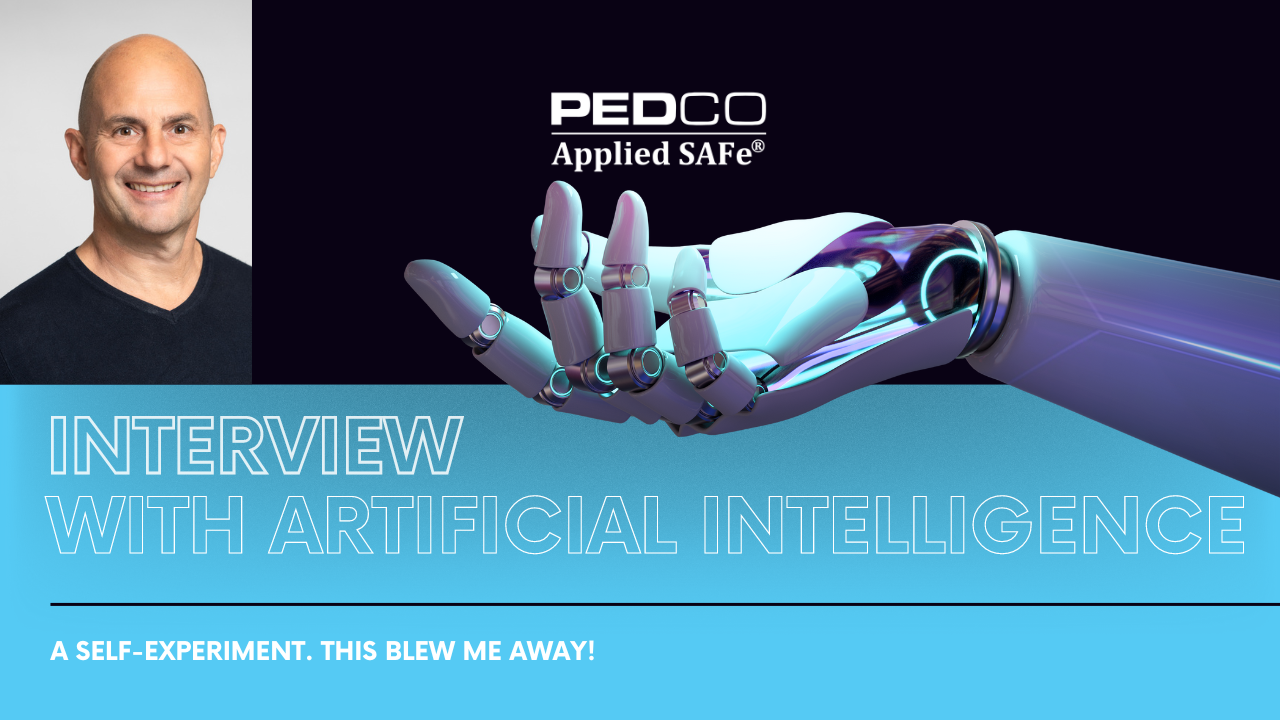Nowadays, the ability for companies to react to market and environmental changes is crucial. In order for companies to be able to react quickly, they must not only “do” Agile but also “be” Agile.
Despite the importance of agility today, many organizations struggle to reap the full benefits of the Agile approach. Why? Because, many are overwhelmed by the considerable transformation effort involved in scaling Agile from its origins as a tactic used in the software field to a program and portfolio level. As a result, they tend to lose focus and momentum, lapsing back into traditional project-management modes.
When organizations lose this focus and start to move back into traditional ways of working it typically means that they tried to implement Agile practices but did not change the mindsets of the people. In other words, they adopted methodologies without values and applied frameworks without principles.
This is a main reason why we see that an overwhelming majority (90%) of organizations today practice Agile to some extent, but only a mere 20% ever achieve maturity.
Because of this, Capgemini Research Institute conducted in-depth interviews with over 45 executives from global organizations in various sectors that have scaled Agile beyond IT or at a program or portfolio level to learn about what and why they do what they do.
First, it is important to define 3 key things: Agile, Agile at Scale, and Business Agility
Agile
Agile refers to the mindset and behaviors that support an iterative, incremental approach to manage changes in design, build, deployment and adoption of products in a highly flexible and interactive manner. Typically, it involves self-governing, crossfunctional teams working on the product. In this case, “product” might be any kind of deliverable from an Agile team, such as software, a customer product, a process improvement, or a marketing campaign, etc.
Agile at Scale
The simplest form of Agile product development is at team-level – which is the foundation. However, in order to create a holistic Agile organization, the practices, values, principles and mindsets of Lean-Agile must be applied beyond teams – to programs, portfolios, and beyond IT as well. This, in turn, is how you start moving from “doing” agile to “being” agile. Frameworks such as the Scaled Agile Framework® (SAFe®), empowers complex organizations to achieve the benefits of Lean-Agile software and systems development at scale.
Business Agility
SAFE ® defines business agility as: “The ability to compete and succeed in the digital age by responding quickly to market changes and opportunities with innovative business solutions. It requires that all those involved in providing solutions – business and technology leaders, development, IT operations, law, marketing, finance, support, compliance, security and others – apply lean and agile procedures to continuous Providing innovative, quality products and services faster than the competition.”
So, how do we achieve these results as we are looking to scale?
It will be clear to many in the organization that the traditional business model is being disrupted and that a delayed reaction could come at a high price. Because of this, it is necessary to establish a need for change and to achieve a faster time to market.
As an organization is looking to start with their transformation, it is necessary to start with and establish “why” there is a need and urgency for this change. Once you understand the “why” then you need to clearly define the organization’s future state.
1. You need to start small and then scale.
When you start small, you can have quick tangible customer outcomes which will then, in turn, be easily marketable. This also gives you a few ‘quick wins’ which start to get you buy-in early on from leadership, which will start to change the mindset and then understanding of why what you’re doing in important.
2. Remember that culture comes last.
Some individuals think that if you go straight to modifying the cultural mindset of the leadership team, you will get the momentum you need for lasting results. False.
Changing the behaviors and mindsets of people first is really what will change the culture within an organization. However, it is important to note that it is an iterative cycle:
- Change one small environmental thing =>
- to create the space to change one small process =>
- which slightly shifts my confidence based on a known track record =>
- which motivates me to make another environmental tweak…
Overall, you can not change a belief system, until you first have some positive behavioral evidence, which only happens after you create a safe and stable operational environment.
In order to achieve a full cultural change, we need to extend agility beyond IT and move into having business agility in whole.
3. Govern: Link Agile Portfolio planning and operations with business strategy
The focus on innovation, speed, and customer experience requires organizations to reset the way they govern their strategic portfolios. These, in turn, should be aligned with a clear vision, objectives, roadmap, and overall organizational strategy.
In order to do this you need to use Objectives and Key Results (OKRs), implement continuous planning, fund customer journeys, decentralize decision making, and more.
The head of group design office at a leading UK-based bank mentioned, “We are less focused on KPIs and more focused on OKRs. So KPIs traditionally will go with a target, and a stretch target. OKRs essentially say that they are stretching right from the get-go. The idea is you’re never going to achieve an OKR in its entirety – it is a different mindset and behavior.”
A great example of continuous planning is the PI Plannings which is ingrained in SAFe and a part of the essential configuration. Program Increment (PI) Planning is a cadence-based, face-to-face event that serves as the heartbeat of the Agile Release Train (ART), aligning all the teams on the ART to a shared mission and Vision.
The Agile Manifesto states, “The most efficient and effective method of conveying information to and within a development team is a face-to-face conversation.” SAFe takes this to the next level with PI planning, a routine, face-to-face event, with a standard agenda that includes a presentation of business context and vision followed by team planning breakouts—where the teams create their Iteration plans and objectives for the upcoming PI.
Finally, decentralize decision making is necessary to be able to deliver value in the shortest sustainable lead-time. It has been proven that most decisions that must be escalated to higher levels of authority introduce a delay, leading to longer lead times. As SAFe mentions, Some decisions, then, should be centralized. Generally, they share the following characteristics:
- Infrequent – Made infrequently, these decisions typically are not urgent, and deeper consideration is appropriate (ex., product strategy, international expansion).
- Long-lasting – Once made, these decisions are unlikely to change at least in the short term (e.g., commitment to a standard technology platform, commitment to organizational realignment around Value Streams).
- Provide significant economies of scale – These choices deliver large and broad economic benefits (e.g., a common way of working, standard development languages, standard tooling, offshoring).
Overall, Understanding how decisions are made helps enable knowledge workers to approach the decision-making process with a clearer point of view
4. Accelerate: Modernize IT with DevOps and microservices
Leading organizations are combining DevOps and Agile efforts, introducing modularity in their systems, and progressively retiring legacy systems. DevOps is a mindset, a culture, and a set of technical practices. It provides communication, integration, automation, and close cooperation among all the people needed to plan, develop, test, deploy, release, and maintain a Solution.
A Quality Manager at a UK based water utilities says, “If you don’t have Agile and DevOps working hand in hand, then you cannot deliver the benefit early. This is because you are not making the best use of automation, release management, and you are not planning your releases well – you are not getting released windows defined.”
Agility is not a destination – it’s an ongoing commitment to deliver customer value faster and adapt quickly to changing conditions.
This article is a summary of the Agile at Scale: Four ways to gain enterprise-wide agility by Capgemini Research Institute. If you wish to reach the full report please visit: https://www.capgemini.com/research/agile-at-scale/





